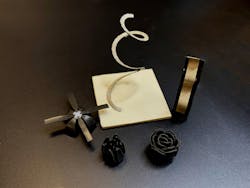New Magnetic Compound Changes Shapes in Response to Magnetic Field
A team of Georgia Tech and Ohio State University researchers has developed a soft polymer material, called magnetic shape memory polymer, that uses magnetic fields to transform into a variety of shapes. The material could be used in new applications ranging from antennas that change frequencies on the fly to gripper arms for delicate or heavy objects.
The material is a mixture of three different ingredients: two types of magnetic particles—one for inductive heat and one with strong magnetic attraction—and shape-memory polymers to help lock various shape changes into place.
“This is the first material that combines the strengths of all of these individual components into a single compound that can rapidly change shape on command, and those shapes are lockable and reversible,” says Jerry Qi, a mechanical engineering professor at Georgia Tech.
An assortment of objects made from magnetic shape-memory polymers. (Credit: Shuai Wu, OSU)
The team made the material by distributing particles of neodymium iron boron (NdFeB) and iron oxide into a mixture of shape-memory polymers. The researchers molded that compound into various objects designed to evaluate how the material performed in a series of applications.
For example, the team made a gripper from a T-shaped mold of the magnetic shape memory polymer mixture. Applying a high-frequency, oscillating magnetic field to the object heated the iron-oxide particles through induction and warmed the entire gripper. That temperature rise, in turn, softened the mixture and made it pliable. A second magnetic field was then applied to the gripper, making the claws open and close. Once the shape memory polymers cool down, they remain locked in that position.
The shape-changing action takes only a few seconds, and the material’s strength at its locked state lets the gripper lift objects up to 1,000 times its own weight.
“We envision this material being useful for situations where a robotic arm would need to lift a delicate object without damaging it, such as in the food industry or for chemical or biomedical applications,” Qi says.
The researchers tested other applications, including one in which coil-shaped objects made from the new material expanded and retracted, simulating how an antenna could potentially change frequencies when actuated by magnetic fields.
“This process requires us to use of magnetic fields only during the actuation phase,” Zhao said. “So, once an object has reached its new shape, it can be locked there without constantly consuming energy.”


